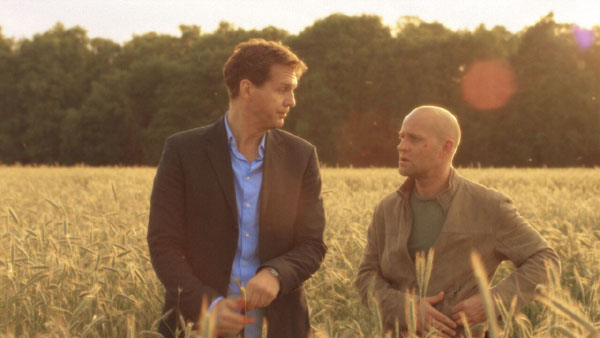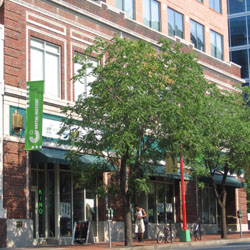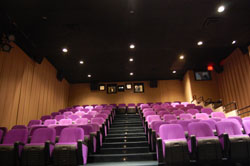Blochin – The Living and the Dead. There are layers of meaning to that title, not the least of which relates to Blochin himself, the eponymous character with no first name.

But before getting into Blochin’s backstory, I shall answer the question posed in this post: “Might Blochin do for Teutonic noir what The Bridge, The Killing, and Wallander did for Nordic noir on both sides of the Atlantic?” Answer: Perhaps. Among the ifs for which a more definitive answer depends is whether Blochin – The Living and the Dead (Blochin – Die Lebenden und die Toten) gets distribution in the US and UK.
Now on to Blochin. As a 14-year-old boy in 1984, he becomes the victim of an attack… and wakes up in the morgue, remembering nothing. Not even his name. (So how does he come to be called Blochin? Sorry. While not exactly a spoiler, it would still be telling.)
Fast forward to 2014 Berlin. The tattooed, motorcycle-riding, street-wise Blochin (Jürgen Vogel, The Wave, The Free Will) is a cop with Homicide Division 7, working alongside his clean-cut brother-in-law Lt. Dominik Stötzner (Thomas Heinze, Tatort, Marie’s Mind for Murder). Were it not for Blochin’s MS-suffering wife Inka and their nine-year-old daughter Grille, the police partners would probably have nothing to do with each other outside of work, so little do they have in common.
One murder case, though, sets off a chain of events that brings Blochin and Dominik closer than either of them ever thought possible. It could also ruin them, if not get them killed.
(Apologies that I couldn’t locate a trailer with English subtitles. Just know that this scene involves Blochin’s learning details about certain events on the night of the murder.)
But then the investigation is yanked away from Division 7 by the Feds, and the hot-headed Blochin begins his own, unofficial one. This brings him face to face with his criminal past, including a former friend from 15 years ago who is still deep in Berlin’s drug scene and about to get deeper. Their reunion turns sour. Then ugly. And things get worse. For both of them.
And for others, too, as the case isn’t limited to just officers of the law looking for a killer. It extends to senior members within Berlin politics, including the Interior Minister’s state secretary, who happens to be having an affair with Dominik.
Under most other circumstances, Blochin wouldn’t turn to Dominik for help, but his wife is getting sicker, something from his past has come back to haunt him in a big way, and he can’t do anything about either situation. He could, though, for the latter, just not on his own. For Inka’s sake, Dominik agrees. However, his cover-up for Blochin has unexpected consequences.

And that, ladies and gentlemen, is the gist of just the first episode of Blochin‘s five.
As the multi-stranded story unfolds, Blochin and Dominik find themselves embroiled in political intrigue, dealing with menacing figures from Berlin’s organized crime underworld, and fending off threats of all sorts, while Blochin pieces together fragments from his past that shadow him in the here and now.
The dark and intense Blochin – The Living and the Dead had me riveted during its six-hour run-time, and it’s well worth a watch if you can get to the only imminent screening in the US that I know of: at the Goethe-Institut Washington.

Located in downtown Washington, DC, the Goethe-Institut Washington is part of the national Goethe-Institut, the cultural institute of the Federal Republic of Germany. The Washington office serves the Mid-Atlantic areas of the District of Columbia, Maryland, Virginia, West Virginia, and Delaware.
In addition to offering German language courses, the Goethe-Institut Washington presents various cultural events — including film and television screenings, exhibitions, panel discussions, and theatre performances — that promote and foster German culture as well as international cultural, social, and political cooperation. Their themed events and dialogues, related to contemporary topics, challenges, and pressing issues within both Germany and the global society at large, support the exchange of culture and ideas between North America and Germany.
The screening of Blochin – The Living and the Dead, is another of the Goethe-Institut Washington’s television events. It follows the successful multi-evening screenings of the Dominik Graf crime drama In Face of the Crime (Im Angesicht des Verbrechens) last year, for which audience members returned week after week for the serial’s ten episodes.

The Goethe-Institut Washington is presenting all five episodes of Blochin – The Living and the Dead in its own professional-grade theatre, located within its offices at 812 7th St. NW, on Mondays — the 6th, 13th, and 20th of July 2015 — starting at 6:30 PM.
Tickets for each of the three screenings cost $7 for the general public and $4 for members of the Goethe-Institut Washington, seniors, and students with a valid ID. They can be puchased in person at the Goethe-Institut’s box office or online at www.boxofficetickets.com/goethe.
Created and directed by Matthias Glasner (The Free Will, Mercy), Blochin – The Living and the Dead is a production of REAL FILM Berlin GmbH. It premiered in February 2015 at the Berlin International Film Festival. Amongst its costars are Maja Schöne (Tatort) as Blochin’s wife, Inka; Jördis Triebel (Lagerfeuer) as Katrin Steinbrenner, Dominik’s politician paramour; Carol Schuler (Stuttgart Homicide) as Conchita, Blochin’s druggie hooker amiga; Agnieszka Piwowarska (Zeppelin!) as Doreen, another friend from Blochin’s past; and Christoph Letkowski (Parkour) as fellow cop Yorik.
__________________
Add your comments on our Facebook and Twitter pages.
Share this post/page.
